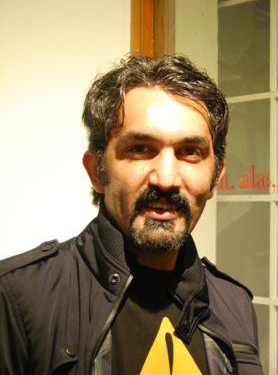
Mughal painting is a style of painting on paper confined to miniatures either as book illustrations or as single works to be kept in albums (muraqqa), from the territory of the Mughal Empire in South Asia. It emerged from Persian miniature painting and developed in the court of the Mughal Empire of the 16th to 18th centuries. Battles, legendary stories, hunting scenes, wildlife, royal life, mythology, as well as other subjects have all been frequently depicted in paintings.

Indian painting has a very long tradition and history in Indian art, though because of the climatic conditions very few early examples survive. The earliest Indian paintings were the rock paintings of prehistoric times, such as the petroglyphs found in places like the Bhimbetka rock shelters. Some of the Stone Age rock paintings found among the Bhimbetka rock shelters are approximately 10,000 years old.

The Lahore Museum is a museum located in Lahore, Punjab, Pakistan. Founded in 1865 at a smaller location and opened in 1894 at its current location on The Mall in Lahore during the British colonial period, Lahore Museum is Pakistan's largest museum, as well as one of its most visited ones.

Punjabi culture grew out of the settlements along the five rivers which served as an important route to the Near East as early as the ancient Indus Valley civilization, dating back to 3000 BCE. Agriculture has been the major economic feature of the Punjab and has therefore formed the foundation of Punjabi culture, with one's social status being determined by landownership. The Punjab emerged as an important agricultural region, especially following the Green Revolution during the mid-1960's to the mid-1970's, has been described as the "breadbasket of both India and Pakistan". Besides being known for agriculture and trade, the Punjab is also a region that over the centuries has experienced many foreign invasions and consequently has a long-standing history of warfare, as the Punjab is situated on the principal route of invasions through the northwestern frontier of the Indian subcontinent, which promoted to adopt a lifestyle that entailed engaging in warfare to protect the land. Warrior culture typically elevates the value of the community's honour (izzat), which is highly esteemed by Punjabis.
Shahzia Sikander is a Pakistani-American visual artist. Sikander works across a variety of mediums, including drawing, painting, printmaking, animation, installation, performance and video. Sikander currently lives and works in New York City.

Abdur Rahman Chughtai was a painter artist and intellectual from Pakistan, who created his own unique, distinctive painting style influenced by Mughal art, miniature painting, Art Nouveau and Islamic art traditions. He is considered to be 'the first significant modern Muslim artist from Pakistan', and the national artist of Pakistan.
Ambreen Butt is a Boston-based Pakistani American artist best known for her drawings, paintings, prints, and collages, and has been recognized for her labor intensive, painted self-portraits that portray feminist and political ideas through traditional Persian art. She now resides in Dallas, TX.
Rashid Rana is a Pakistani artist. He has been included in numerous exhibitions in Pakistan and abroad with his works in abstractions on canvas, collaborations with a billboard painter, photographic/video performances, collages using found material, photo mosaics, photo sculptures, and large stainless steel works.

Painting is the practice of applying paint, pigment, color or other medium to a solid surface. The medium is commonly applied to the base with a brush, but other implements, such as knives, sponges, and airbrushes, can be used.
Wasli, also referred to as wasli paper, is a type of handmade paper used specifically for painting miniatures. It was devised in India, in the 10th century, and figures widely in Mughal-era painting.

Hasnat Mehmood is a Pakistani visual artist who lives and works in Dubai, UAE. He was born on 3 March 1978 in Jhelum.
Ustad Bashir Ahmed, son of Barkat Ali Malik, was born in Lahore, Pakistan in 1954. He is a Pakistani painter, also known as Moughal Miniature Painter.
Shiva Ahmadi is an Iranian-born American artist, known for her paintings, videos, and installations. Her work has been exhibited at galleries and museums in North America and the Middle East.
Aisha Khalid is a female contemporary visual artist, working with miniature painting, textiles, video and site specific installations in architectural spaces.
Waseem Ahmed is a contemporary miniature painter and visual artist, living and working in Lahore, Punjab, Pakistan.
Saira Sheikh (1975-2017) was an artist who was head of the liberal arts program at the Indus Valley School of Art and Architecture (IVS), where she also taught as an associate professor. She created multiple artworks, most of which were created with Omer Wasim, a visual artist.
Pakistani art has a long tradition and history. It consists of a variety of art forms, including painting, sculpture, calligraphy, pottery, and textile arts such as woven silk. Geographically, it is a part of Indian subcontinent art, including what is now Pakistan.
Khadim Ali is an Australian painter of Afghan descent, a member of the Hazaras ethnic group.
Abdullah Qureshi is a Queer Muslim Pakistani cis-male artist, social activist, curator, educator, and cultural producer. Qureshi utilizes paint, watercolor, film, and faceless depictions of his male friends to capture his personal histories, trauma, and childhood memories surrounding his identity as a Queer Muslim Pakistani man. When revealing his identity, Qureshi tends to do this within an Abstract Expressionist style using large canvases. Additionally, when unpacking his identity, he tends to do this within the context of his experiences with immigration and his intimate and healing experiences with men.






